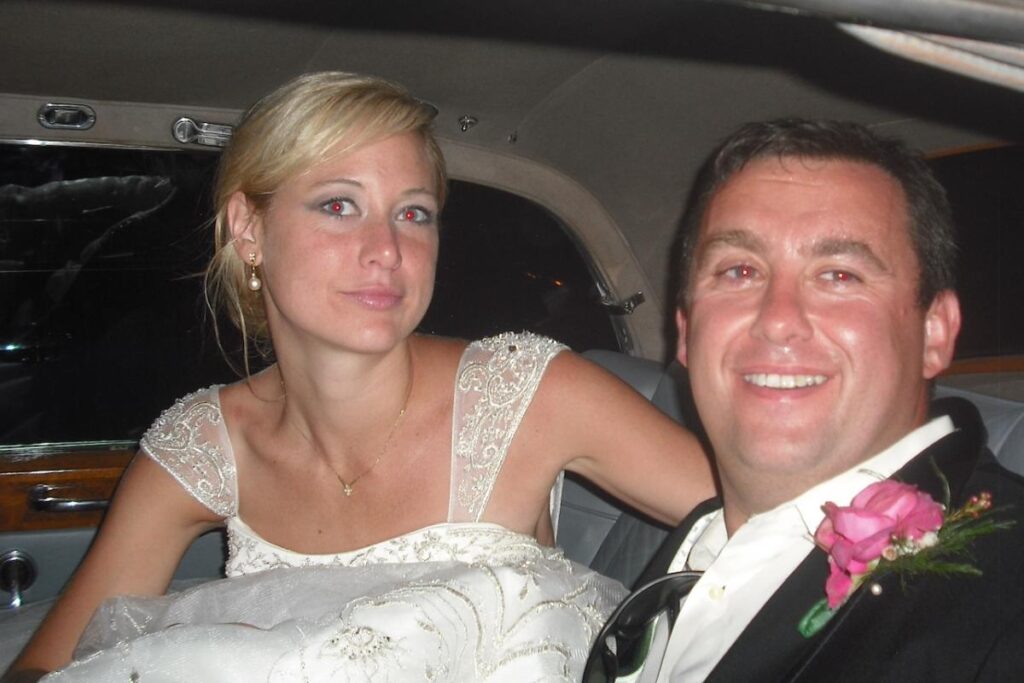Those who are ready to feel icky about lots of things about life and existence can fire up new Netflix true-crime documentary A Deadly American Marriage, which chronicles the utter destruction of a family in the untimely 2015 death of husband and father Jason Corbett. Directed by Jenny Popplewell and Jessica Burgess, the film plays out suspensefully if you don’t know much about the somewhat high-profile decade-long legal battle that ensued – and for a movie that tells a story laced with psychological manipulation and allegations of brainwashing, it sure seems to be manipulating its audience in order to keep us on a yo-yo. You might be better off reading the Wikipedia page for this one.
The Gist: In 2006, Jason Corbett was living in Ireland when his wife Mags died of complications from an asthma attack, leaving him to raise his young children Sarah and Jack on his own. He couldn’t handle the burden of working full time and caring for the kids, so he used an au pair service to hire Molly Martens, who relocated from the U.S. for the job. Their relationship eventually became more than professional, and they got married in the U.S. in 2011, eventually settling with the kids in North Carolina to start their new life together. By Aug., 2015, Jason was dead. We see Molly and her father, Tom Martens, in police interrogation rooms. Crime scene photos show Molly and Jason’s bedroom splattered with blood. A baseball bat leans against some furniture. A brick is stained with blood, hair still stuck to it. Horrific.
What happened? I’ll leave it to the documentary to both-sides the story and stick to a vague description: Jason and Molly were awakened in the middle of the night when Sarah, then eight years old, had a bad dream. An argument broke out between the two. Tom, who’d been visiting overnight, heard sounds of physical violence, so he grabbed a baseball bat and intervened. In the police interview footage, we see Tom say he hit Jason with a baseball bat, and Molly says she hit Jason in the head with a brick. They killed him, no doubt about it. It’s the contextual circumstances that are in question. Was it self-defense? They claim Jason was violently angry and had choked Molly. But any reasonable third party would look at this scenario and wonder, even if their story is true, if their response wasn’t extreme. The prosecutor on the ensuing criminal trial struggles to describe the state of Jason’s head; his skull was so thoroughly crushed, the pathologist couldn’t determine how many blows Molly and Tom inflicted on it.
Cue Lt. Wanda Thompson, who’s interviewed here: “Are they (Tom and Molly) the victims, or is he (Jason) the victim?” From here, the film outlines the details of the murder trial via interviews with lawyers, police and family members, including now-teenage Jack and Sarah, and Jason’s sister Tracey Corbett-Lynch and brother-in-law David Lynch (no relation to the filmmaker), who took custody of the children. We’re subject to a character profile of Jason as a friend to everybody and a devoted dad. Everyone points to the evidence stacked against Molly and Tom, discrepancies in their story and issues with their character – she appears to be a compulsive liar, and he’s a former FBI agent schooled in the skill of interrogation. A decent chunk of the documentary is devoted to the interviews Jack and Sarah did with child psychologists in the wake of their father’s death, and whether Sarah coached them beforehand. Molly and Tom look guilty as hell. Then our jaws hit the floor as Molly and Tom sit down for interviews for this very documentary, and they’re not in orange jumpsuits or behind glass or calling from prison. What gives?
What Movies Will It Remind You Of?: Popplewell dove deep into another true-crime saga for Netflix in American Murder: The Family Next Door.
Performance Worth Watching: Lawyers. They’re always performing in documentaries, and they’re rarely worth watching. They often just muddy the truth with conjecture. (In this doc, the D.A. is more credible than the defense attorneys, who sure come off as guys who are paid a lot of money to distort the truth.) Far too often, they only make things worse. Enough!
Memorable Dialogue: Sarah implies that her dad and Molly’s marriage was fractured leading up to Jason’s death: “On the outside of the house, the house looks like sunshine and rainbows. And on the inside, it’s dark and heavy.”
Sex and Skin: None.
Our Take: I previously mentioned that A Deadly American Marriage both-sides this story, but we don’t hear Molly and Tom’s version of things until deep into the film – deep enough to make you angry that the directors aren’t quite doing this story justice. Listen: I walked away from the film believing the prosecution’s case to be far more convincing. I couldn’t reach that point without hearing Molly and Tom speak. And the film lets us judge their credibility. But Popplewell and Burgess choose to broadside us with a big reveal in lieu of giving us linear journalism, therefore exploiting an already sensationalist case in order to make their film more entertaining – in a word, yuck. We find ourselves navigating the twists and turns and peaks and valleys of a narrative rollercoaster instead of contemplating the ideas that emerge from such tragedies, e.g., if we can ever truly know another person, what makes a healthy marriage, what comprises domestic abuse or how someone can reach such an emotional boiling point that they take a life.
That’s the fine line of true crime that the filmmakers cross, and it’s a bit of a rubicon for the documentary. Which is too bad, because the story warrants a less manipulative and greasy presentation, and it’s rare to see all involved parties, especially those who’ve already faced public scrutiny, participate in this type of doc. It tracks two trials, one that disallowed the interviews with the children as evidence and put Molly and Tom in prison; the second played out in an appeals court that allowed the interviews, got them sprung for a while and let Molly and Tom’s attorneys essentially drag Jason’s character through the mud, going so far as to speculate that he killed his first wife. Jason’s siblings and children likely see the film as an opportunity to reclaim the narrative about their father. But how do Molly and Tom justify their participation? They come off a little… pathological. Don’t they want to put all this behind them? They push back against the extremes of the narrative, so that makes sense. Were they paid to participate? (They were probably paid to participate.)
The third act of the film mostly jumps back and forth between attorneys on both sides of the case – Molly secretly recorded arguments she had with Jason, and one side interprets them as evidence of Jason being abusive, and the other contends that she was hoping to recontextualize their spats in an attempt to control the narrative, get him in trouble with the law and claim custody of the children. Never mind that to the rest of us, the recordings sound like ugly, but generally typical fights between people whose marriage is hitting the rocks – and that the film’s 102-minute chase for the truth might’ve been more journalistically credible if it started in the gray area where the story actually lies. Instead, in the interest of putting its audience on an emotional yo-yo, it veers from the white side to the black side before eventually, wisely, suggesting that the truth lies somewhere in the middle. And it smacks of irresponsible journalism.
Our Call: Journalism is informative. True crime is often voyeuristic and exploitative. A Deadly American Marriage is closer to the latter than the former. SKIP IT.
John Serba is a freelance writer and film critic based in Grand Rapids, Michigan.
Read the full article here








